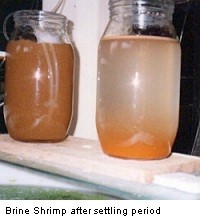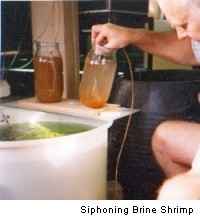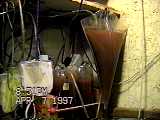

Brine shrimp are small aquatic crustaceans closely related to freshwater fairy shrimps, Copepods and Daphnia. Freshly hatched brine shrimp nauplii have a lipid-rich yolk, high in unsaturated fatty acids. Due to this nutritious yolk, brine shrimp nauplii have become the standard food for larval fish in the aquaculture industry. Brine shrimp can live in freshwater for around 5 hours before they die, making them an ideal live food for many aquarium fishes.


Brine shrimp eggs (cysts) are produced by females during periods of high salinity, shortage of suitable food, low oxygen levels and continuing high temperature extremes. During optimal conditions females usually produce free swimming nauplii. The eggs are collected and can remain dormant for many years as long as they are kept dry and oxygen free. When the eggs are placed into saltwater they are re-hydrated and hatch. Brine shrimp eggs should be maintained in a dry condition at all times. Store opened eggs in an air-tight container in the refrigerator or in a cool dry place. Eggs kept this way will give you a greater hatching rate.
Freshly hatched brine shrimp as a source for larval fish was first reported by Alvin Seale, the Superintendent of the Steinhart Aquarium, USA in 1933. However, it wasn't until the late 1970s that a continuous production of brine shrimp eggs was available. At that time, the major production of eggs occurred in the United States, mainly from San Francisco Bay and the Great Salt Lakes, Utah. More recently, large brine shrimp farms have been set up in many parts of the world. Australia has an endemic species of brine shrimp (Parartemia). Parartemia occurs in saline lakes only in Australia, with about a dozen known species and produce cysts from which the nauplius larvae hatch, similar to Artemia.
Brine shrimp nauplii emerging from their protective shells are extremely small, mostly less than 500 micrometers. At that time, they are bite-size for most aquarium fish fry, except the tiniest of newly hatched egg layers. The size of freshly hatched nauplii differs according to origin. The smallest is believed to be the San Francisco species and the largest was found to be a stain from China.
Brine shrimp nauplii are an excellent live food, not only for fry but also for adult fishes of the smaller species of rainbowfishes such as the Pseudomugil species group and Iriatherina werneri. Brine shrimp nauplii grow rapidly and may double in size in 20 hours or less. They continue to grow through several moults or instar stages and become adults in a couple of weeks time. Therefore, by waiting until the right time after hatching, the aquarist can have the right sized shrimp for his fishes. However, it is important that the shrimp are used as a food source before their nutrient level is depleted.
In recent years, several nutritional enhancement techniques have been developed to improve the nutritional value of brine shrimp by maintaining them for several days in a nutrient-rich medium. Obviously, the time and effort involved in nutritionally enhancing brine shrimp would not be worthwhile for the average aquarist. However, for the serious aquarist with an extensive breeding program, nutritionally enhanced brine shrimp may well be worth the effort. Every aquarist should be familiar with the brine shrimp as they are easily cultured. The standard procedure for hatching nauplii is to incubate the eggs for 24-48 hours in a saltwater solution and then separate the nauplii from the unhatched eggs and shells. I will outline my method for hatching brine shrimp:

I use a 2 litre wide-mouthed glass jar or plastic soda bottle filled with tap water. To this I add 2 slightly heaped measured tablespoons (The dose of salt can vary) of solar salt and a pinch of Sodium bicarbonate. Brine shrimp eggs have been shown to hatch out at salinities ranging from 5 to 35 parts per thousand (ppt). However, research has shown that better hatching results have been achieved at the lower range. During the hatching process, the eggs absorb water through the shell by osmosis. When the osmotic pressure within the egg is great enough, the shell then bursts, freeing the larval brine shrimp. At higher salinities, the osmotic pressure outside the egg is higher than within the egg, lengthening the time for hatching. If you are having problems with poor hatch rates then experiment with different salt levels as I have found that different Brands require different salinity levels.
The pH for the hatching solution may range from 7.5 to 8.5. A pH above 8.5 tends to be too alkaline, while a pH below 6.5 results in a dramatic decrease in the hatching results. The optimum hatching temperature is considered to be 82°F . From 75-85°F at least 90% of premium grade eggs should hatch within an 18 hour period. Lower temperatures will cause the eggs to hatch at a slower rate. The temperature in my case is governed by the air temperature of my fish room. During summer, I harvest the shrimp after 24 hours, winter time 48 hours and spring/autumn 36 hours. I live in Southern California which has a mediterranean type climate and my fishroom rarely drops below 70°F during winter, but in summer it can reach 85 to 88°F. The fishroom is air conditioned and insulated so temperature extremes from the outside are avoided.
The recommended hatching density of eggs should not exceed 1 level teaspoon per litre of water. Constant aeration should be provided by an airline, without an airstone, inserted to reach the bottom of the jar. Proper aeration is essential for two reasons - the maintenance of dissolved oxygen levels, and keeping the eggs suspended in solution. Too little aeration will result in low levels of dissolved oxygen, while too much aeration causes the build-up of foam on the surface of the water. Eggs that become caught up in this foam will not hatch.
After the incubation period, I turn off the aeration and allow the contents to settle for about 5 to 10 minutes. A distinct separation will occur, the hatched egg shells will float to the surface and the unhatched eggs will sink to the bottom. Most of the newly hatched nauplii will accumulate just above the unhatched eggs on the bottom. I then siphon the shrimp into a fine mesh net through a length of air-line tubing, which has a short rigid extension (the depth of the jar) on the intake end. This makes it possible to position and siphon very accurately. Careful siphoning can be time consuming however, this is necessary because unhatched eggs and shells cannot be digested and may become caught in the stomach of small fish, thus leading to mortalities.
I then rinse the nauplii in a gentle stream of freshwater, which removes any waste products and salt residue. The freshly hatched nauplii are then fed to the fish. The jar is then emptied, rinsed, refilled with tap water and the procedure is started all over again. The net should also be rinsed. It is important to collect the nauplii quickly, because after 10 minutes or so, the oxygen levels of the water begin to drop quickly and the nauplii will begin to show signs of distress.
| Back to Articles Menu |
|---|